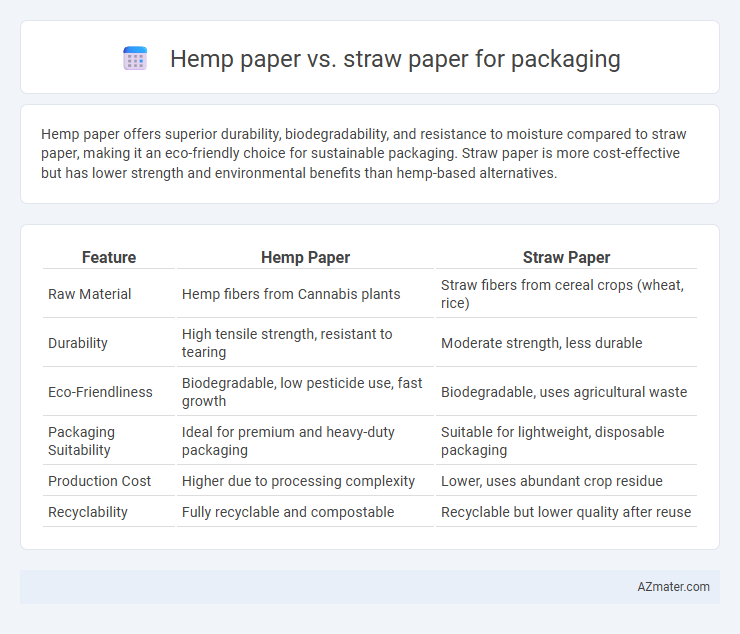Hemp paper offers superior durability, biodegradability, and resistance to moisture compared to straw paper, making it an eco-friendly choice for sustainable packaging. Straw paper is more cost-effective but has lower strength and environmental benefits than hemp-based alternatives.
Table of Comparison
| Feature | Hemp Paper | Straw Paper |
|---|---|---|
| Raw Material | Hemp fibers from Cannabis plants | Straw fibers from cereal crops (wheat, rice) |
| Durability | High tensile strength, resistant to tearing | Moderate strength, less durable |
| Eco-Friendliness | Biodegradable, low pesticide use, fast growth | Biodegradable, uses agricultural waste |
| Packaging Suitability | Ideal for premium and heavy-duty packaging | Suitable for lightweight, disposable packaging |
| Production Cost | Higher due to processing complexity | Lower, uses abundant crop residue |
| Recyclability | Fully recyclable and compostable | Recyclable but lower quality after reuse |
Introduction to Sustainable Packaging Materials
Hemp paper offers exceptional durability and biodegradability, making it a sustainable choice for eco-friendly packaging solutions. Straw paper, derived from agricultural residues, provides an environmentally responsible alternative by repurposing waste and reducing reliance on wood pulp. Both materials contribute to lowering carbon footprints and promote circular economy principles in sustainable packaging industries.
Overview of Hemp Paper Production
Hemp paper production involves processing the bast fibers of the hemp plant, which are long, strong, and cellulose-rich, resulting in durable and eco-friendly paper. The fibers undergo retting, decortication, and pulping before being formed into sheets, offering a sustainable alternative to traditional wood-based paper. Hemp paper's rapid growth cycle and minimal pesticide use significantly reduce environmental impact compared to straw paper production from cereal crop residues.
Overview of Straw Paper Production
Straw paper production involves converting agricultural residues, primarily from wheat, rice, or barley straw, into pulp through mechanical or chemical processes that enhance fiber bonding for durable packaging. This method reduces waste by utilizing otherwise discarded straw, offering a sustainable alternative to wood-based paper, often resulting in a lighter and more biodegradable packaging material. Straw paper's availability and cost-effectiveness make it a practical choice in packaging industries aiming for eco-friendly solutions without compromising strength and print quality.
Environmental Impact: Hemp vs. Straw
Hemp paper offers a significantly lower environmental impact compared to straw paper due to its higher yield per acre and faster growth cycle, which reduces land use and resource consumption. Hemp cultivation requires fewer pesticides and herbicides, enhancing soil health and biodiversity, whereas straw paper production often relies on agricultural waste and may involve chemical treatments that increase pollution. Additionally, hemp paper is more biodegradable and recyclable, supporting a circular economy and minimizing landfill waste relative to straw-based alternatives.
Material Strength and Durability Comparison
Hemp paper exhibits superior material strength and durability compared to straw paper, making it more suitable for robust packaging applications. The long bast fibers in hemp provide enhanced tensile strength and resistance to tearing, while straw paper, derived from cereal crop stalks, tends to be more brittle and less resilient under stress. Consequently, hemp paper packaging offers better protection for heavy or fragile items during shipping and handling.
Cost Efficiency in Packaging Applications
Hemp paper offers higher durability and biodegradability but comes at a significantly higher production cost compared to straw paper, which is more cost-effective due to abundant raw materials and simpler processing. Straw paper provides a competitive edge in packaging applications by reducing overall material expenses while maintaining adequate strength for most uses. Evaluating long-term sustainability goals alongside immediate budget constraints is critical when choosing between hemp and straw paper for packaging.
Biodegradability and End-of-Life Options
Hemp paper and straw paper both offer biodegradable packaging solutions, but hemp paper typically decomposes faster due to its higher cellulose content and fewer lignins. End-of-life options for hemp paper include composting and recycling, with hemp fibers enhancing compost quality, while straw paper also supports compostability but may vary in durability and recycling efficiency depending on processing methods. Choosing between the two depends on specific packaging requirements, with hemp paper favored for sustainable, high-performance biodegradability and circular waste management.
Printability and Branding Potential
Hemp paper offers superior printability due to its high fiber strength and smooth surface, enabling sharper images and vibrant color reproduction, which enhances branding potential for premium packaging. Straw paper provides a more rustic texture, lending a natural and eco-friendly aesthetic ideal for brands emphasizing sustainability, though its print quality may be slightly less precise. Both materials support eco-conscious branding, with hemp paper better suited for detailed graphics and straw paper favoring organic, minimalistic designs.
Supply Chain and Availability Issues
Hemp paper offers superior sustainability but faces limited supply chain scalability due to lower global cultivation and processing infrastructure compared to straw paper. Straw paper benefits from abundant agricultural byproducts and established supply chains, ensuring more consistent availability and lower transportation costs for packaging manufacturers. Variability in regional crop yields and processing facilities heavily impacts the timely delivery and pricing stability of both materials within global packaging markets.
Conclusion: Choosing the Best Eco-Friendly Packaging
Hemp paper offers superior durability and biodegradability compared to straw paper, making it an excellent choice for sustainable packaging solutions. Straw paper, often more cost-effective and easier to source, provides a viable alternative for businesses aiming to reduce environmental impact without compromising budget constraints. Selecting between hemp and straw paper ultimately depends on specific packaging needs, balancing factors like strength, environmental footprint, and economic feasibility.

Infographic: Hemp paper vs Straw paper for Packaging
 azmater.com
azmater.com